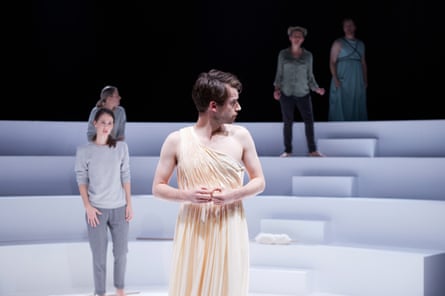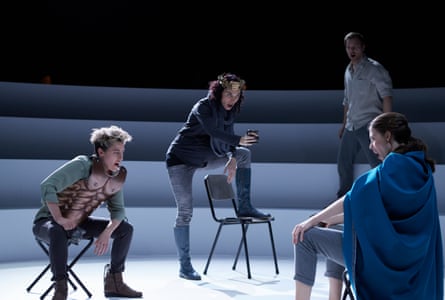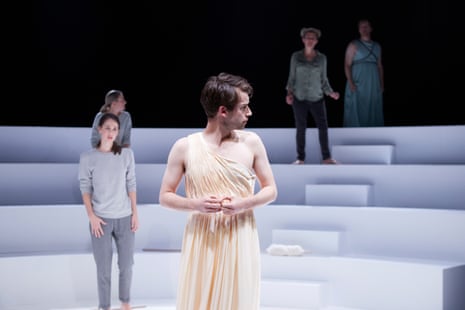Of all the performances designed to shock or confront at this year’s Dark Mofo, so far it’s a mid-20th century British opera, The Rape of Lucretia, that has been the most unsettling to watch – despite the effort made by this production to recraft it for the modern age.
The story begins with men away at war who have heard rumours of their wives sleeping around. One man, Tarquinius, resolves to rape the only wife who has been faithful – Lucretia – to prove that every woman is a whore deep down.
Lucretia, once raped, feels such shame and self-loathing she kills herself with a knife. The end.
First staged in Glyndebourne in 1946, the two-act opera has long been Benjamin Britten’s “problem piece” and is rarely performed. But in 2018 in Australia, less than a week after yet another young women, Eurydice Dixon, was raped and murdered, it raises a whole other question: in the age of MeToo, how do you tackle a work such as this? Should you even try?
Directed by Kip Williams, this particular production, which premiered last year at Carriageworks, comes from Sydney Chamber Opera and the Tasmanian Symphony Orchestra, and the performers and artistic directors are all aged in their 20s and 30s. They found one way around the gender problems of the text by reversing the roles of men and women in many scenes, including the rape scene.

Women perform the roles of the male soldiers, lip-syncing the words as they are sung by the male performers who shadow them; and men play Lucretia and her friends. But despite excellent staging and magnificent performances (it’s so far been well reviewed) there were some walkouts and debates in the foyer. And after a week of heavy reporting in the media about violence against women, I felt unsettled. Did I really want to end the week watching two hours of a woman being raped in her home, and her subsequent shame and suicide?
Melanie Tait, a Hobart local and occasional Guardian contributor, only stayed for half the performance on Saturday night.
“I have no interest in exploring a piece of art where men tell me what rape is,” she said.
“It’s written by a man and a directed by a man, and I had no desire to sit and watch the rest of it when I knew where the story would end up – with a rape. I would ask, ‘Why was it shown? What was the point?’”
To her, the production’s gender-flip wasn’t enough to justify its programming. “I question why the artistic decision was made. What did the gender bending add to the piece? I couldn’t figure it out. I was very aware the entire time of the woman being raped – and every other woman [character] was trashed in it. All those old views of women … it was gross.”
The work was last performed in the country by a major Australian opera company in 1971, at the Sydney Opera House. So why bring it back?
Jack Symonds, the artistic director of the Sydney Chamber Opera, told Guardian Australia, “That’s what every opera company has to ask. When you choose something like this, you have to weigh up the musical and dramatic worth of a problematic piece before you even interpret it.
“What Britten offers in this piece is the opportunity to look at the way we have historically constructed gender roles in marriage and society, and what happens when they are broken.”
The production couldn’t mess with the libretto for copyright reasons, but by switching the men’s and women’s roles, they could comment on the text without overtly disrupting it.
“If you play it straight, there will be a large segment of the audience who will absorb lines like ‘all women are whores by nature’ – and this was an issue with the work,” says Symonds.

Symonds did receive some criticism from audience members, he says, but they weren’t complaints about its content; rather, that the performance was not faithful enough to the original.
“The reaction in Sydney [last year] was very split down gender and age lines, and theatre and opera lines,” said Symonds. “Most people from theatre world really loved it, while traditional opera audiences really wanted a group of men running around in Roman costumes.
“I got a lot of complaint emails from people who saw Benjamin Britten come to Australia [in 1970] – they are the generation who are the guardians of his legacy. And [they thought] this [production] was heresy.”
The issue about whether and how we should continue to stage or display art whose content is offensive in a modern context is not a new one. Recently, it was raised in February when John William Waterhouse’s painting Hylas and the Nymphs was removed from the walls of the Manchester Art Gallery.
Clare Gannaway, the gallery’s curator of contemporary art, said the title of the work was problematic, as it was the male gaze depicting passive women and femmes fatales: “For me personally, there is a sense of embarrassment that we haven’t dealt with it sooner. Our attention has been elsewhere ... we’ve collectively forgotten to look at this space and think about it properly,” she said.
Likewise, with the Rape of Lucretia, Symonds acknowledges that the opera is a “fraught piece” which comes with an in-built trigger warning in the form of its title. But, he says, making work that is confronting to both feminists and traditionalists is the point of art.
“If we just go to the theatre to reinforce anything we know, then why do it? There are going to be things that are triggering. [The MeToo movement] is a time that theatre should make sense of through the prism of art.”
